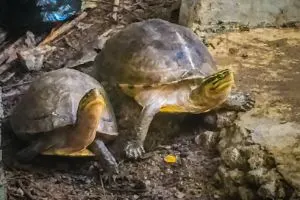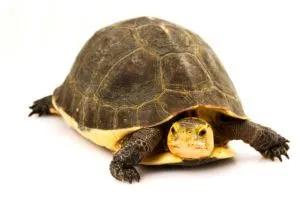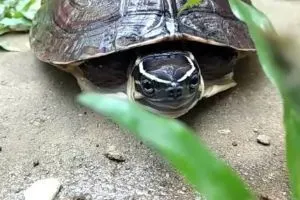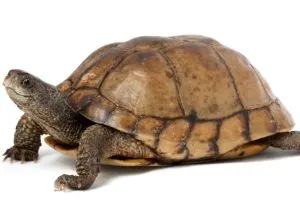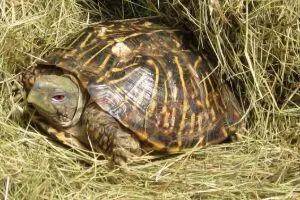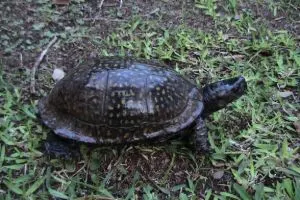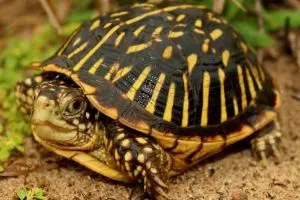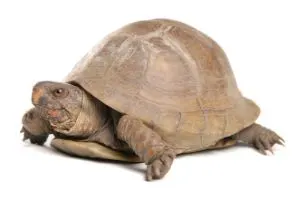Below you will find a few of the many different types of Box Turtle Species. In order to make filtering easy we have categorized them from smallest to largest along with some highlights of each like colors and alternate names.
Before jumping in, here are some pages that you should find helpful
- Overview of how to keep a Box Turtle as a Pet
- Turtle & Tortoise Identification Guide
- Cost of Turtle & Tortoise Ownership
- Is Your Tortoise A Boy Or Girl
- Can box turtles swim
- What do Box Turtles eat?
- Box turtle breeding
- Do Box turtles hibernate?
- How to build a Box Turtle setup
- How to choose the best substrate for a box turtle setup
To learn more about each type of box turtle, just click on the title and you will be taken to a more in depth overview of the box turtle and how to care for it.
1. Asian Box Turtles (Overview)
- Family: Geoemydidae
- Genus: Cuora
- Binomial Name: Various
- Other Names: Various
- Type: Semi-Aquatic
- Size: 12 inches (30 cm)
- Lifespan: 100 years
There are 12 subspecies in the grouping of Asian Box turtles which are native to areas of Southeast Asia, including China, Indonesia, parts of India, and the Philippines.
Asian Box turtles from the Cuora genus usually have reddish to brown or even black domed shells with three distinctive keels. The keels in many cases will have vibrant stripes running down them including colors like yellow, orange, and even white.
Most Asian Box turtles are omnivores, and can either be aquatic, semi-aquatic, or terrestrial. Unfortunately, they are also the most commonly trafficked type of turtle in the world. They are used as a food source as well as in the pet trade.
2. Chinese Box Turtle
- Family: Geoemydidae
- Genus: Cuora
- Binomial Name: Cuora flavomarginata
- Other Names: Golden-headed turtle, Yellow-margined Box turtle, Snake-eating turtle
- Type: Semi-Aquatic
- Size: 5.5 to 6.5 inches (14 to 16cm)
- Lifespan: 100 years
Chinese Box turtles are found in central areas of China, as well as in parts of Japan and Taiwan. These beautiful semi-aquatic turtles have distinctive yellow margins to their lower bodies. Their highly domed shells are a dark brown color, and they have yellow stripes on their keels.
Chinese Box turtles are omnivorous and will usually eat fruits, vegetables, mollusks, and worms. They favor subtropical climates with a high humidity and warm temperatures. These active turtles like to burrow into the ground to keep themselves humid.
3. Malaysian Box Turtle
- Family: Geoemydidae
- Genus: Cuora
- Binomial Name: Cuora amboinensis kamaroma
- Other Names: Amboina Box turtle, Southeast Asian Box turtle
- Type: Semi-Aquatic
- Size: 8 inches (20 cm)
- Lifespan: 35 years
Malaysian Box turtles are a local subspecies of the Southeast Asian Box turtle, also known as the Amboina Box turtle. This particular subspecies is found in regions of Indochina, including Malaysia, Singapore, Thailand, and Vietnam.
Malaysian Box turtles prefer tropical habitats with warm water and high humidity. They have dark brown shells with fewer black spot patterns than other Southeast Asian Box turtles. Malaysian Box turtles also have shorter and smaller tails than their cousins.
These turtles can survive in some pretty extreme conditions, but are unfortunately Endangered. Malaysian Box turtles are omnivores, although older individuals will eat more vegetation.
4. Coahuilan Box Turtle
- Family: Emydidae
- Genus: Terrapene
- Binomial Name: Terrapene coahuila
- Other Names: Aquatic Box turtle
- Type: Aquatic
- Size: 3-6in (15-20 cm)
- LifeSpan: 65 years
Coahuilan Box turtles are the most endangered type of Box turtle. They are endemic to the area surrounding the city of Cuatro Cienegas in the Coahuila region of Mexico. Unlike virtually every other Box turtle, the Coahuilan Box turtle is almost completely aquatic.
Coahuilan Box turtles have dark brown to black shells without distinctive markings. Because they live mostly in water, their shells can carry a lot of algae. They inhabit springs in the desert of their small region and are opportunistic omnivores.
5. Desert Box Turtle
- Family: Emydidae
- Genus: Terrapene
- Trinomial Name: Terrapene ornata luteola
- Other Names:Sonoran Box turtle
- Type: Semi-aquatic
- Size: 4-5in (10-13 cm)
- LifeSpan: 30-40 years
- States: Arizona, New Mexico, Texas
Desert Box turtles are a subspecies of Box turtle that has adapted to living in more arid, open habitats. The Desert Box turtle is native to only the southwestern regions of the United States and northern parts of Mexico. They spend most of their time on land.
Desert Box turtles have dome-shaped shells that range from brown to reddish-brown. These semi-aquatic turtles have thinner markings than Ornate Box turtles. Desert Box turtles are omnivores and mainly feed on insects like grasshoppers. They will also eat vegetation such as cacti, plants, and fruit.
6. Eastern Box Turtle
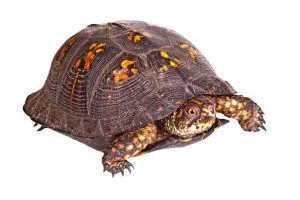
- Family: Emydidae
- Genus: Terrapene
- Trinomial Name: Terrapene carolina carolina
- Other Names: Land turtle
- Type: Semi-aquatic
- Size: 4-7in (10-18 cm)
- LifeSpan: 65 years
- States: Alabama, Connecticut, Delaware, Florida, Georgia, Illinois, Indiana, Kansas, Kentucky, Maine, Maryland, Massachusetts, Michigan, Mississippi, New Hampshire, New Jersey, New York, North Carolina, Ohio, Pennsylvania, Rhode Island, South Carolina, Tennessee, Virginia, West Virginia
Eastern Box turtles are a colorful subspecies of the Common Box turtle. Their high domed dark brown shells sport distinctive yellow and orange markings. Their plastrons are also dark brown. Eastern Box turtles have the unique ability to regenerate their shells.
These largely terrestrial turtles can roam up to 50 meters a day in search of food, preferring woodland regions along with grasslands and marshy areas in eastern and central parts of the U.S. They stay close to ponds and streams. Eastern Box turtles are omnivores will eat fish and invertebrates as well as plants.
7. Gulf Coast Box Turtle
- Family: Emydidae
- Genus: Terrapene
- Trinomial Name: Terrapene carolina major
- Other Names: N/A
- Type: Semi-aquatic
- Size: 6 to 8.5 inches (15 to 21.5 cm)
- LifeSpan: 30 to 40 years
- States: Florida, Georgia
Gulf Coast Box turtles are the largest of the Common Box turtle subspecies, reaching up to 8.5 inches in length. They are found in brackish waters, estuaries, and swamps around the Gulf of Mexico. This semi-aquatic species prefers warm, humid areas.
Gulf Coast Box turtles have dark brown or black shells with fluted edges and yellow dot or stripe markings. The intensity of these markings can vary wildly from turtle to turtle. Gulf Coast Box turtles are omnivores, and will eat anything from carrion to insects, as well as mollusks and worms.
8. Ornate Box Turtle
- Family: Emydidae
- Genus: Terrapene
- Trinomial Name: Terrapene ornata ornata
- Other Names: Box tortoise, Western Box turtle
- Type: Aquatic
- Size: 4-5in (10-13 cm)
- LifeSpan: 30 to 40 years
- States: Arizona, Arkansas, Colorado, Illinois, Indiana, Iowa, Kansas, Louisiana, Missouri, Nebraska, New Mexico, Oklahoma, South Dakota, Texas, Wisconsin, Wyoming
Ornate Box turtles are a beautiful, colorful species. The distinctive patterning on their dark brown or black shells forms a series of yellow to orange stripes. The Ornate Box turtle is the state reptile of Kansas and can be found across much of the central and western United States.
Ornate Box turtles are largely terrestrial, preferring open habitats such as grasslands or prairies, especially in the Great Plains region. These diurnal, omnivorous turtles spend much of their time foraging for food. They have relatively small territories but have recently faced population decline due to habitat loss and the pet trade.
9. Three-toed Box Turtle
- Family: Emydidae
- Genus: Terrapene
- Trinomial Name: Terrapene carolina triunguis
- Other Names: Box turtle
- Type: SemiAquatic
- Size: 4-5in (10-13 cm)
- LifeSpan: 30-40 years
- States: Arkansas, Florida, Georgia, Louisiana, Mississippi, Missouri, Oklahoma, Tennessee, Texas
Three-toed Box turtles are a subspecies of the Eastern Box turtle found in Central and Southern areas of the United States. The Three-toed Box turtle is the state reptile of Missouri. These turtles prefer grassland areas such as meadows as well as woodland, and can adapt well to changes in habitat.
Three-toed Box turtles have high domed carapaces which are usually brown or olive in color. They also have three claws on their hind-legs, as their name implies, rather than four. Their plastrons are yellowish in color. Three-toed Box turtles are omnivores; eating insects, mollusks, worms, and vegetation.
10. Mccord’s Box Turtle
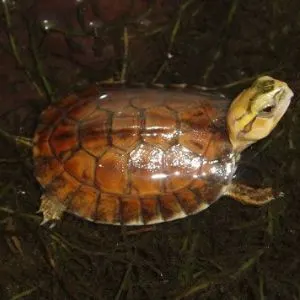
- Experience Level: Advanced
- Family: Geoemydidae
- Scientific Name: Cuora mccordi
- Average Adult Size: 5.5 – 7.1in1(4-18cm)
- Average Lifespan: 30 – 40 years
- Diet: Carnivorous
The Mccord’s box turtle is highly sought after as a traditional Chinese medicine and because of this reason is one of the most endangered Chinese turtles.
11. Mexican Box Turtle
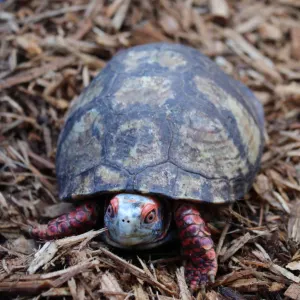
- Experience Level: Intermediate
- Family: Emydidae
- Scientific Name: Terrapene mexicana or Terrapene carolina mexicana
- Common names: Mexican box turtle, Tamaulipan Box Turtle
- Average Adult Size: 7 to 8 inches (177 to 200 mm)
- Average Lifespan: 100 years in the wild
- Diet: Omnivorous
Mexican box turtles are not common as pets as they have not been bred successfully currently. They are native to Mexico which is where both their common and scientific name come from.
12. Spotted Box Turtle

- Experience Level: Advanced
- Family: Emydidae
- Scientific Name: Terrapene nelsoni
- Average Adult Size: 5.5 to 6 inches (138 to 152 mm)
- Average Lifespan: 25 years in captivity
- Diet: Omnivorous
The spotted box turtle has two subspecies which are the Northern and Southern box turtle. They are primarily found in the Sierra Madre region and are sought after because of their uniquie look with their spots.
13. Northern Box Turtle
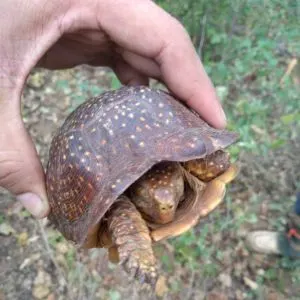
- Experience Level: Advanced
- Family: Emydidae
- Scientific Name: Terrapene nelsoni klauberi
- Other Names: Northern Spotted Box Turtle, Klauber’s Box Turtle, Klauber’s spotted box turtle
- Average Adult Size: 6 inches (15 cm)
- Average Lifespan: 27 years in captivity
- Diet: Omnivorous
The northern box turtle is limited to the Sierra Madre Occidental in montane regions. It has several other names as well and generally the name refers to the northern spotted box turtle. This turtle is a subspecies of the spotted box turtle. It is also called the Klauber’s spotted box turtle or the Klauber’s box turtle.
14. Southern Box Turtle
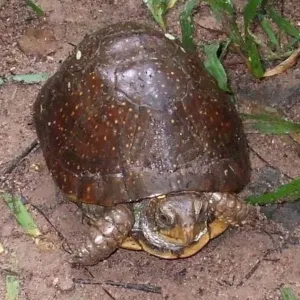
- Experience Level: Advanced
- Family: Emydidae
- Scientific Name: Terrapene nelsoni nelsoni
- Other Names: Southern Spotted Box Turtle
- Average Adult Size: 6 inches (15 cm)
- Average Lifespan: 25 years in captivity
- Diet: Omnivorous
The southern spotted box turtle (Terrapene nelsoni nelsoni) is sometimes referred to as the southern box turtle. The southern box turtle is endemic to the southern part of the spotted box turtle’s geographic range (which is the Sierra Madre Occidental).
15. Yucatan Box Turtle

- Experience Level: Intermediate
- Family: Emydidae
- Scientific Name: Terrapene carolina yucatana / Terrapene yucatana / Terrapene mexicana yucatana
- Average Adult Size: 6 inches (152 mm)
- Average Lifespan: 40 years in captivity, 100 years in the wild
- Diet: Omnivorous
The Yucatan box turtle is a subspecies of the common box turtle that is sometimes considered to be an individual species (Terrapene yucatana).
In terms of appearance, all these turtles look similar. They have dome-shaped carapaces and hinged shells. This allows the chelonian to retract into its shell and close it off.

